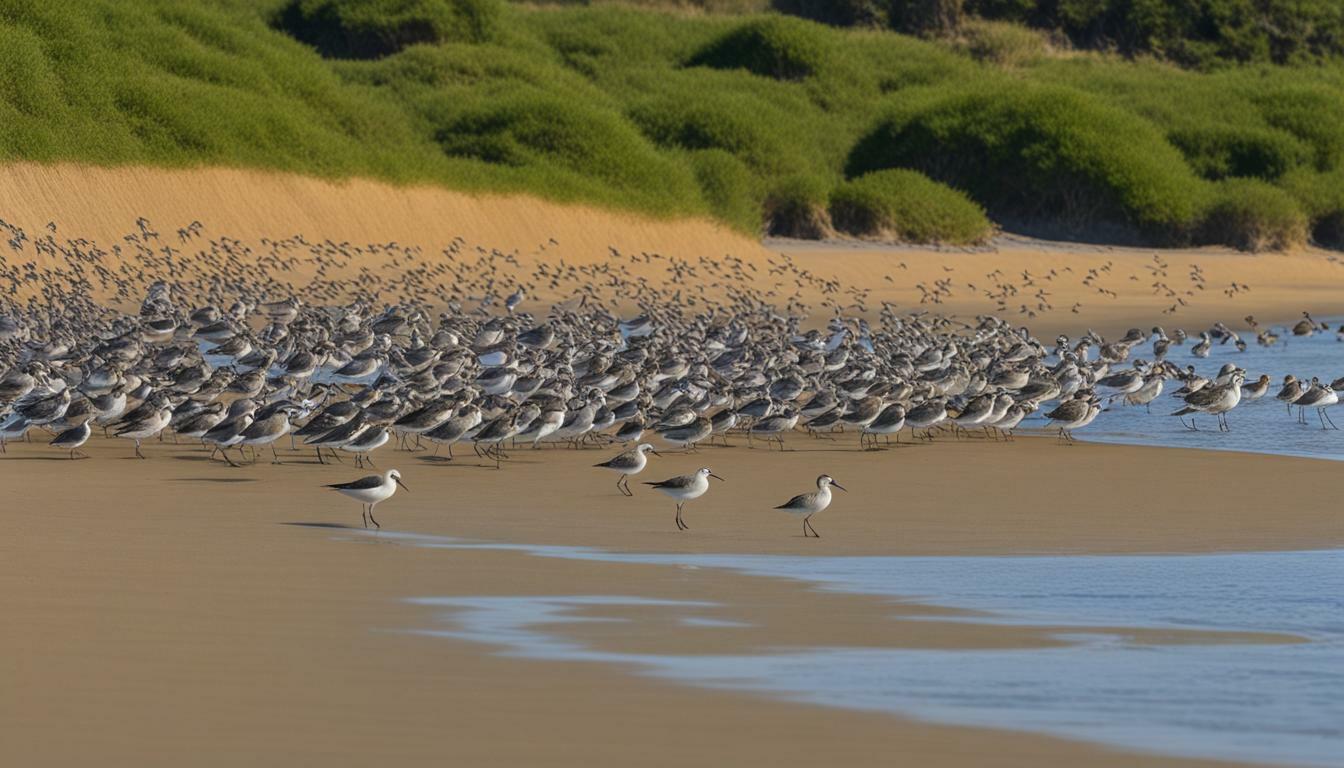For birdwatchers and nature enthusiasts, shorebirds and waders may seem like two interchangeable terms for describing similar birds. However, while both groups share similarities, they have distinct differences in habitat, behavior, and physical characteristics. In this article, we’ll explore the key differences between shorebirds and waders, highlighting their unique features and behaviors.
Key Takeaways:
- Shorebirds and waders are two distinct groups of birds, with differences in habitat, behavior, and physical characteristics.
- Understanding the distinctions between shorebirds and waders is important for birdwatchers and nature enthusiasts.
Habitat and Characteristics of Shorebirds and Waders
Shorebirds and waders encompass a wide variety of species that can be found in a range of different habitats. Shorebirds, as their name suggests, are often found on shorelines, mudflats, and sandy beaches, but can also be seen in marshes, grasslands, and tundra habitats. Some of the most common shorebird species include sandpipers, plovers, and dunlins.
Waders, on the other hand, tend to prefer freshwater habitats like rivers, lakes, and wetlands, but can also be seen on coastal shores. Some of the most well-known wader species include herons, egrets, and cranes.
One of the key physical characteristics that distinguishes shorebirds from waders is their beak shape. Shorebirds typically have long, thin beaks that are ideal for probing and plucking food from sand or mud, while waders have longer, thicker beaks that they use to spear fish or capture larger prey. Additionally, shorebirds tend to have long legs for wading through shallow water and sand, while waders often have sturdy legs for standing in deeper water.
Both shorebirds and waders are also known for their impressive migratory behaviors. Many species travel thousands of miles each year to breed, feed, and winter in different locations around the world.
Interestingly, some shorebirds can even fly non-stop for up to 90 hours during their migrations, covering distances of over 11,000 miles!
Shorebird Species
Shorebirds include a wide range of species, from the tiny Least Sandpiper (which weighs just over half an ounce) to the larger Whimbrel (which can weigh up to 1.6 pounds). Some of the most common shorebirds in North America include:
- Black-bellied Plover
- Least Sandpiper
- Sanderling
- Ruddy Turnstone
Wader Species
Waders are also incredibly diverse, with species ranging from the small and delicate Snowy Egret to the large and imposing Sandhill Crane. Some of the most commonly seen waders in North America include:
- Great Blue Heron
- Snowy Egret
- Green Heron
- Sandhill Crane
These species are just a small sample of the many different shorebirds and waders that can be found in the wild. By understanding their unique characteristics and habitats, birdwatchers can gain a deeper appreciation for these fascinating and beautiful creatures.
Migratory Behavior of Shorebirds and Waders
One of the most fascinating aspects of shorebirds and waders is their incredible migratory behavior that takes them across continents and oceans. These birds are well-known for undertaking some of the longest and most challenging journeys of any bird species, often flying for thousands of miles non-stop.
Most shorebirds and waders are migratory, traveling between their breeding and non-breeding grounds each year. The timing and routes of these journeys vary between species and are influenced by a range of factors, including food availability, daylight hours, and weather conditions.
Many shorebirds, such as sandpipers and plovers, breed in the Arctic tundra and then migrate to warmer regions, such as South America, Africa, or Australia, for the non-breeding season. Other species, like the Red Knot, undertake remarkable journeys, traveling from the Arctic to the southern tip of South America in one non-stop flight that can last up to seven days.
Waders, on the other hand, tend to migrate shorter distances, with many species found in Europe and Asia traveling to Africa for the winter. However, some waders, such as the Bar-tailed Godwit, undertake similarly impressive journeys to their shorebird counterparts, traveling from northern Alaska to New Zealand or Australia non-stop.
Migratory shorebirds and waders rely on a network of stopover sites along their journeys, where they rest and refuel before continuing on. These stopover sites can be anywhere from small pond-side marshes to expansive wetlands, and their importance cannot be overstated. Many of these sites are threatened by habitat loss, pollution, and climate change, underscoring the need for continued conservation efforts to protect these remarkable birds.
In summary, the migratory behavior of shorebirds and waders is an awe-inspiring feat, taking these birds across vast distances and highlighting the importance of preserving their habitats along the way.
Feeding Habits of Shorebirds and Waders
Shorebirds and waders have a diverse range of feeding habits, and their beak shapes and feeding techniques are highly specialized for their unique diets.
Shorebirds, for instance, have long and thin beaks that are perfect for probing into the sand or mud for small crustaceans, insects, and mollusks. Some species, such as the American Woodcock, have sensitive beaks that can detect vibrations indicating the presence of prey.
Waders, on the other hand, have longer and sturdier beaks that are perfectly adapted for catching fish, amphibians, and other aquatic prey. Some species of waders, such as the Black Skimmer, have lower mandibles that are much longer than the upper mandibles, which helps them to skim the surface of the water while feeding.
Many shorebirds and waders also have unique feeding behaviors that make them stand out. For instance, the Greater Yellowlegs has a distinct high-pitched call that it uses to flush out small prey from the mud before quickly stabbing at them with its beak.
Overall, the feeding habits of shorebirds and waders are fascinating to observe, and their specialized beaks and techniques provide important clues about their ecology and behavior.
Nesting Habits and Reproduction of Shorebirds and Waders
Shorebirds and waders have distinct nesting habits and reproductive behaviors that vary depending on the species. Mating rituals, nest construction, and parental care differ greatly between different types of shorebirds and waders.
For example, some shorebirds, like sandpipers, lay their eggs in shallow nests in the sand or gravel. These nests are often difficult to spot and are vulnerable to predators and human disturbance. Other shorebirds, like plovers, create scrapes in the ground and lay their eggs directly in the depression.
Waders, on the other hand, tend to nest in more vegetated areas. The American bittern, for instance, builds its nest in a dense marsh and camouflages it with surrounding vegetation. Other waders, like the common snipe, build their nests on the ground in moist soil or dense vegetation.
Shorebirds and waders also have different approaches to parental care. Some species, like the northern jacana, have females that mate with multiple males and leave the males to care for the eggs and hatchlings. Other species, like the ruddy turnstone, have both parents take turns incubating the eggs and feeding the young.
It’s important for birdwatchers and nature enthusiasts to be mindful of the nesting habits and reproductive behavior of shorebirds and waders. Disturbing nesting sites can have detrimental effects on the survival of the next generation of these birds.
Physical Features and Identification of Shorebirds and Waders
Shorebirds and waders can be distinguished by their unique physical characteristics, which are adapted to their respective habitats and feeding behaviors.
Shorebirds
Shorebirds are generally small to medium-sized birds with long legs and bills. They have streamlined bodies that allow them to move quickly and easily over mudflats and sandy beaches. Their bills are thin and pointed, which enables them to probe into the sand and mud for invertebrates like insects, crustaceans, and mollusks.
Some common physical features of shorebirds include:
- Narrow, pointed bills
- Long, thin legs
- Pale underwings
- Dull-colored plumage
Identifying specific shorebird species can be challenging, as many species look very similar. However, paying attention to bill shape and size, leg color and length, and overall body shape can help with identification.
Waders
Waders, also known as herons and egrets, are larger than shorebirds and have longer bills and necks. They are often found foraging in shallow water, searching for fish, amphibians, and other aquatic prey. Their long legs enable them to wade in deep water without getting wet, while their bills are adapted for spearing fish and other prey.
Some common physical features of waders include:
- Long, pointed bills
- Long, thin legs
- Plumage that is often white, gray, or blue
- Distinctive crests or plumes on the head and/or neck
Identifying specific wader species can be easier than identifying shorebirds, as their large size and distinctive plumage makes them more recognizable. However, paying attention to bill length and shape, as well as any unique crests or plumage patterns, can help with identification.
Conclusion
As we’ve seen, knowing the difference between shorebirds and waders is essential for anyone interested in birdwatching or nature observation. While both groups share some similarities, including their elongated legs and affinity for aquatic habitats, they differ in several important ways.
Shorebirds typically inhabit sandy or rocky shorelines, while waders can be found in a variety of wetland environments, including marshes, mudflats, and shallow ponds. Additionally, shorebirds tend to be more active during the day, while waders may be active during both day and night.
Feeding habits also differ between the two groups, with shorebirds using their long, slender beaks to probe for invertebrates in the sand or mud, while waders may employ a variety of techniques to catch fish, crustaceans, or insects, depending on the species.
Why it Matters
By understanding these distinctions, birdwatchers and nature enthusiasts can better appreciate the unique characteristics and behaviors of these fascinating groups of birds. Furthermore, knowing the typical habitats and migratory patterns of shorebirds and waders can help us identify and protect the important stopover sites and breeding grounds that these species rely on.
So whether you’re a seasoned birdwatcher or simply a lover of the natural world, taking the time to learn about the difference between shorebirds and waders is a rewarding and enriching experience.
Thank you for reading!
 Skip to main content
Skip to main content


